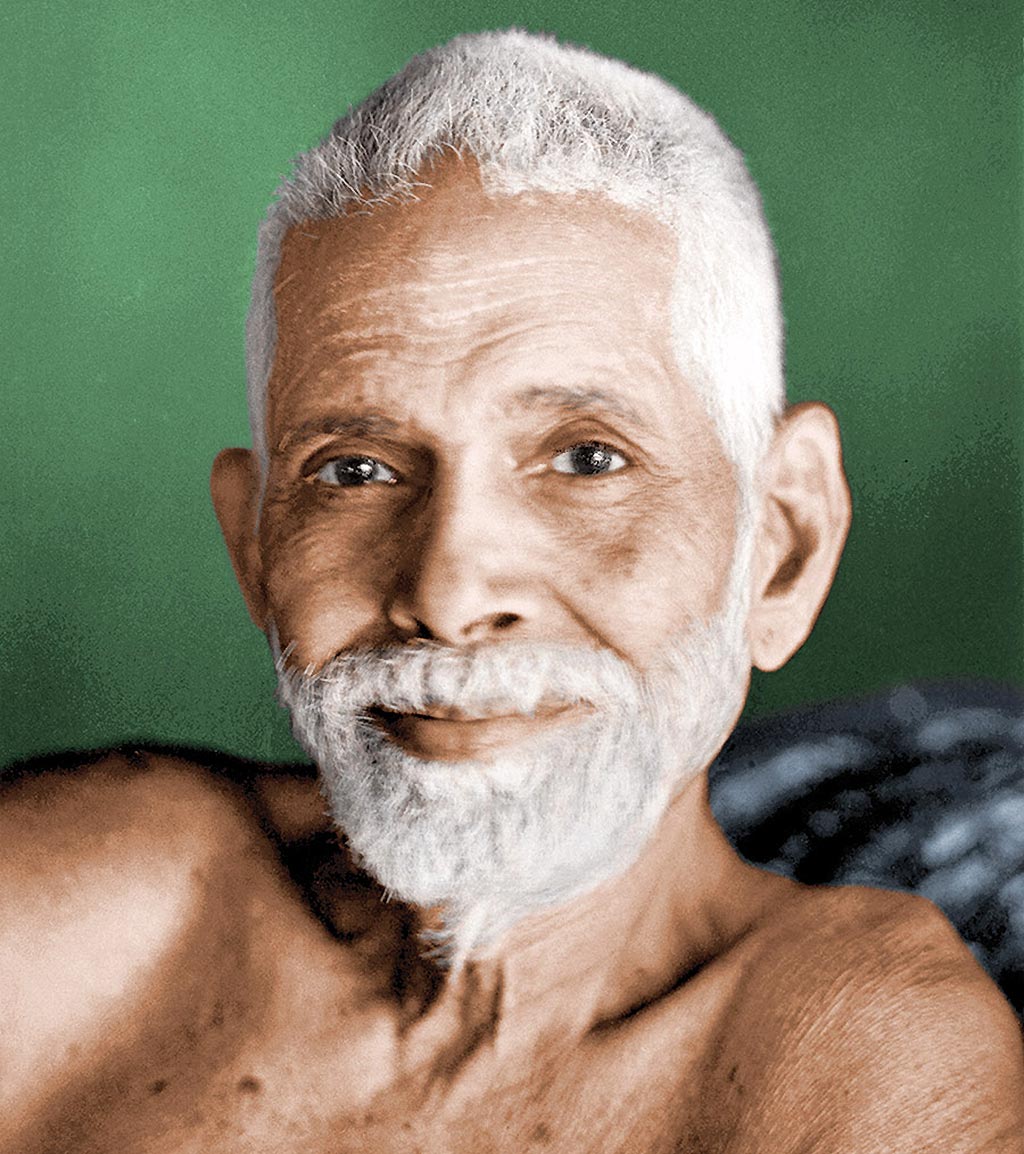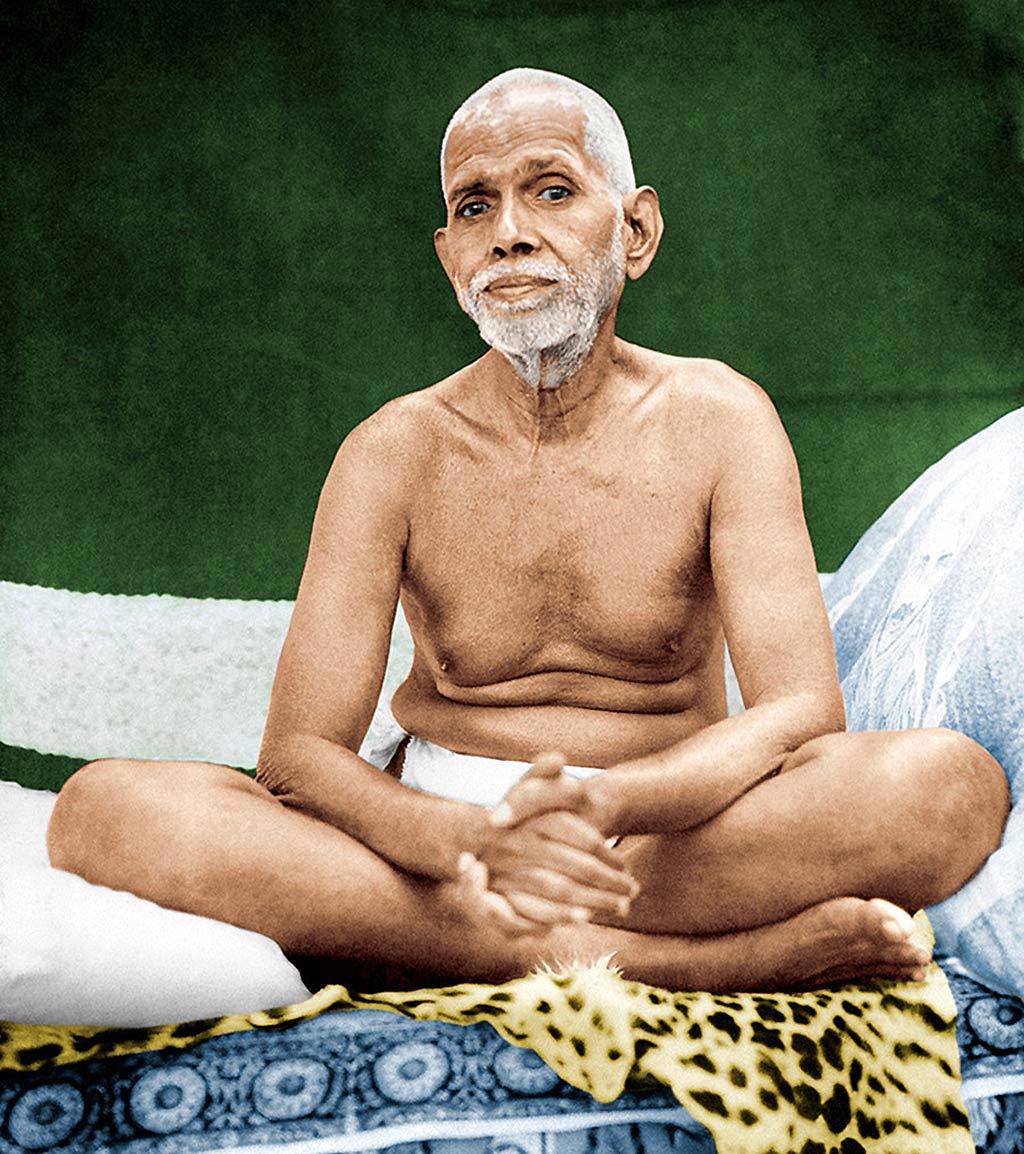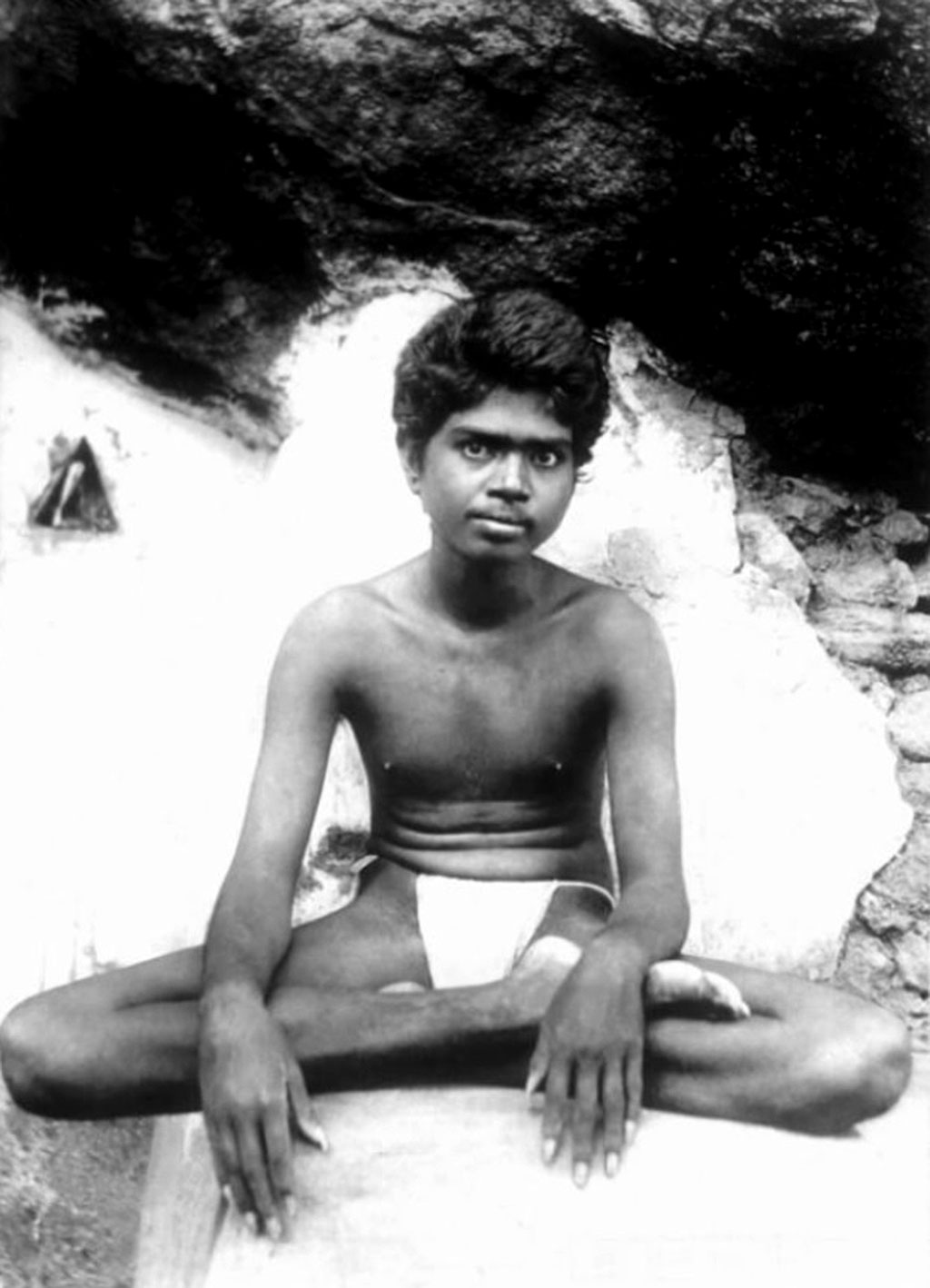
Teachings of non-duality and the practice of self inquiry are hugely popular today. There are dozens of satsang-only teachers these days. Each promoting a style of spiritual inquiry inspired by the life and teaching of Sri Ramana Maharshi.
Sri Ramana Maharshi is without doubt one of the most influential spiritual teachers of our modern age. In fact, many would say that he is one of the most influential spiritual teachers of all time.
One of the most well known of these teachers is Sri Mooji Baba. Mooji is a student or Papaji, who was himself a direct student of Sri Ramana.
Who is Sri Ramana Maharshi?
Bhagavan Sri Ramana Maharshi was born Venkataraman Iyer on the 30th December, 1879.
His message was incredibly simplistic, direct and lucid. No one can overstate the importance of the life and teaching of Sri Ramana Maharshi. Its relevance and importance to the modern day spiritual quest is tantamount to that of the Buddha. He elucidated profound and, most importantly, exceptionally accessible teachings on Self inquiry.
Ramana barely spoke a word for the majority of his life. Preferring instead the direct transmission of wisdom through his silent presence. However, his students recorded the little that he did say. They made copies of things he wrote and compiled many books of his teachings.

THE LIFE OF BHAGAVAN RAMANA
By all accounts, including his own, he was a very regular child. He showed no specific spiritual inclination. However, at the young age of 16, a sudden fear of death gripped the young Venkataraman.
This fear instigated a profound process of inquiry into the nature of that which dies. In turn, this inquiry lead to a direct experiential understanding of that which does not die. I.e. the spirit, or the pure (unconditioned) ‘I Am’.
This experience of the sense of ‘I’ became the central and sole focus of the teachings of Bhagavan Ramana.
ON HIS AWAKENING
“One day I sat up alone on the first floor of my uncle’s house. I was in my usual health. I seldom had any illness. I was a heavy sleeper. … So, on that day as I sat alone there was nothing wrong with my health. But a sudden and unmistakable fear of death seized me. I felt I was going to die.
THE FIRST SELF INQUIRY
Why I should have so felt cannot now be explained by anything felt in my body. Nor could I explain it to myself then. I did not however trouble myself to discover if the fear was well grounded. I felt ‘I was going to die,’ and at once set about thinking out what I should do. I did not care to consult doctors or elders or even friends. I felt I had to solve the problem myself then and there.
The shock of fear of death made me at once introspective, or ‘introverted’.
I said to myself mentally, i.e., without uttering the words – ‘Now, death has come. What does it mean? What is it that is dying? This body dies.’ I at once dramatized the scene of death. I extended my limbs and held them rigid as though rigor-mortis had set in. I imitated a corpse to lend an air of reality to my further investigation.
I held my breath and kept my mouth closed, pressing the lips tightly together so that no sound might escape. Let not the word ‘I’ or any other word be uttered! ‘Well then,’ said I to myself, ‘this body is dead. It will be carried stiff to the burning ground and there burnt and reduced to ashes. But with the death of this body, am “I” dead? Is the body “I”? This body is silent and inert. But I feel the full force of my personality and even the sound “I” within myself, – apart from the body.
THE REVELATION
So “I” am a spirit, a thing transcending the body. The material body dies, but the spirit transcending it cannot be touched by death. I am therefore the deathless spirit.’
All this was not a mere intellectual process, but flashed before me vividly as living truth, something which I perceived immediately, without any argument almost. ‘I’ was something very real, the only real thing in that state, and all the conscious activity that was connected with my body was centered on that. The ‘I’ or my ‘self’ was holding the focus of attention by a powerful fascination from that time forwards. Fear of death had vanished once and forever. Absorption in the Self has continued from that moment right up to this time. Other thoughts may come and go like the various notes of a musician, but the ‘I’ continues like the basic or fundamental sruti note which accompanies and blends with all other notes.
Whether the body was engaged in talking, reading or anything else, I was still centered on ‘I’.”
Extract taken from the book ‘Ramana Maharshi: His Life’ by Gabrielle Ebert

LIFE AFTER AWAKENING
This remarkable experience had a life changing impact on the young Ramana. Six weeks after this event he took the last 5 rupees that he would touch in his life. He left his parents home and went in search of a sacred mountain named Arunachala.
When he arrived at Arunachala he stopped speaking (and would not speak another word for more than 10 years). At first he sat in temples at the foot of the mountain absorbed in meditation.
Eventually he moved to a cave on the side of the mountain named Virupaksha. There he remained meditating for around 20 years. The life and teaching of Sri Ramana Maharshi deeply reflects this dedication to meditation on the truth of reality.
– Sri Ramana Maharshi – On Arunachala
Recognising the very special condition of the young Venkataraman, a number of sadhus began to gather around him. They took care of his bodily needs while he remained absorbed in deep meditative states. They also sat in silence with him and derived much inspiration and understanding from the depth of his silent presence.

– Sri Ramana Maharshi
Ramana meditated almost continuously without speaking for around 10 years. By this time his reputation had begun to spread. Subsequently, spiritual practitioners would travel long distances to spend time in the presence of the silent sage.
Ramana would occasionally respond to questions in writing. One of the early question and answer sessions with the silent sage was recorded and published as the book ‘Who Am I’.
Ganapati Muni approached Sri Ramana for spiritual instruction. Receiving the teachings on self Inquiry, Ganapati felt deeply moved. He then named the silent sage Sri Bhagavan Ramana Maharshi. Thereafter he was known by this name.
THE FIRST SPOKEN TEACHING OF SRI RAMANA
The first time that Ganapati Muni made a visit to the cave of Sri Ramana he asked a question about tapas, yogic discipline.
“All that has to be read I have read. Even Vedanta Sastra [the holy scriptures of Vedanta] I have fully understood. I have performed japa to my heart’s content. Yet I have not up to this time understood what tapas is. Hence have I sought refuge at thy feet. Pray enlighten me about the nature of tapas.”
For 15 minutes, Sri Ramana looked silently into the eyes of Ganapati Muni. As per his usual teaching style of silent transmission. However the flustered Ganapati Muni was unable to receive the teaching and implored Sri Ramana to help him further.
Bhagavan Ramana answered:
“If one watches whence this notion of “I’ springs, the mind will be absorbed into that. That is tapas. If a mantra is repeated, and attention directed to the source whence the mantra-sound is produced, the mind will be absorbed in that. That is tapas.”
This was the first time Sri Ramana had answered a question with spoken words.
– Sri Ramana Maharshi – Talking about his own death
THE DEATH OF BHAGAVAN SRI RAMANA MAHARSHI
Bhagavan Sri Ramana Maharshi died, or left his physical body on April 14th 1950.
He died of a particularly painful type of cancer. He did express that there was some pain and difficulty in his body. However he remained calm and lucid up until the end of his physical life.
He continued to offer darshan until the very end of his life.
THE DEATH OF SRI BHAGAVAN RAMANA, IN THE WORDS OF HIS ATTENDANT
There was another problem. Devotees wanted to have the darshan of their Guru.
I did not want to incur their anger by denying them one last darshan of their Guru. I requested them to come in a queue and not put any questions or expect any words of wisdom from Bhagavan.
Darshan continued till 5 p.m.devotees came in large numbers, and although police kept the line moving fast, they went back and stood in line again, weeping and crying. It was a sight that moved me very deeply.
Seeing the difficulty that Bhagavan was experiencing, I drew a screen across and didn’t allow any more darshan. O. P. Ramaswani Reddiyar came, and I told him that he could come in, but he declined. Seeing how much Bhagavan’s body was suffering, O. P. Reddiyar requested the devotees to sing “Aksharamanamalai.” He did this because Bhagavan’s body was suffering and he didn’t want anybody to notice it.
Bhagavan had told me that a Jnani does not mind how his body is dropped, for the body idea has already died. It was only for the naked eye that Bhagavan was suffering. In reality there was no suffering since Bhagavan had no dehatma buddhi (I-am-the-body idea).
THE FINAL MOMENTS
Lots of pillows were placed to prop up his head and He was sitting with his legs stretched. Suddenly, Bhagavan asked me to seat him in padmasana pose, and in that pose the last breath went out of him, and he became still.
When Bhagavan dropped the body, I was holding the head, and Subramanian was standing next to me. I was looking at Bhagavan’s face, and when the lower jaw dropped, I knew that he had left the body. The women outside sensed it somehow and, beating their breasts, tried to come inside and have one last darshan. But the police prevented it. I helped carry the body to the Mandapam of the mother’s temple. My service to Bhagavan ended there.
CONCLUSION
Again and again in the life and teaching of Sri Ramana Maharshi we see a life of humility, service, transparent wisdom and grace.
May these stories and examples serve as points of reflection. May they inspire us all to live a life following this example. An unconditional devotion to the deepest experiential knowing of truth available to us.